Best Hurricane Shutters
A hurricane shutter is simply a physical barrier installed to the exterior of a building to protect a window, or door, from damage during a storm. The best hurricane shutters endure strong winds, flying debris, and a high volume of moisture for the duration of the event. The success of the storm shutters is usually in direct correlation with the material composition and the quality of installation on the window.
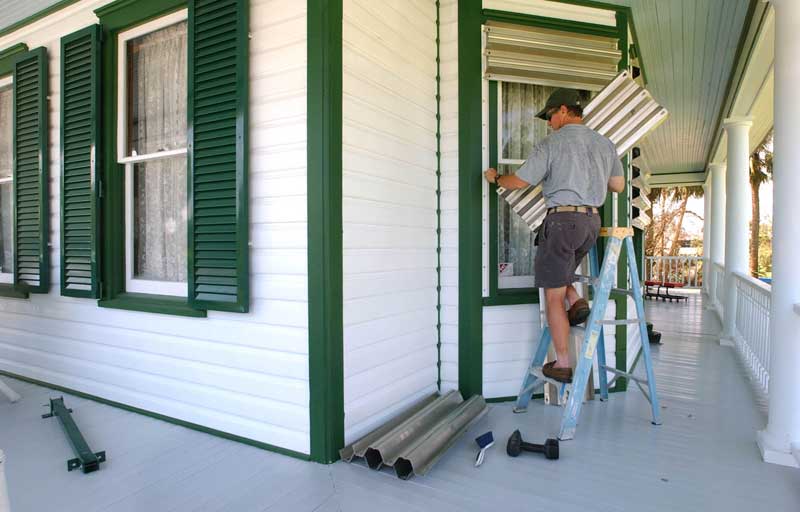
Hurricanes, Typhoons & Cyclones
The terms “hurricane,” “typhoon,” and “cyclone” are names given to the same type of storms based on the geographical location. Cyclones develop in the south Pacific and Indian Oceans. Typhoons occur in the western Pacific Ocean, and hurricanes originate in the Atlantic and eastern Pacific Oceans.
Storms are categorized by wind speed.
Tropical Depression: Thunderstorms with wind speeds of less than 38 mph.
Tropical Storm: Strong thunderstorms with wind speeds between 39 & 73 mph.
Category 1 – Wind speeds 74 – 95 miles per hour
Category 2 – Wind speeds 96 – 110 miles per hour
Category 3 – Wind speeds 111 – 130 miles per hour
Category 4 – Wind speeds 131 – 154 miles per hour
Category 5 – Wind speeds 155 miles per hour
“Hurricane season” refers to the months of each year that have been historically accompanied by hurricanes or tropical storms. The recognized hurricane season is from June through November each year. The peak season occurs between August to October, with mid-September as the pinnacle. Each period is unpredictable, delivering mild tropical storms with moderate rains and winds or Category 5 hurricanes resulting in extensive damages. That is why it is important to install hurricane shutters during the off season.
Why Install Hurricane Shutters
In recent years, hurricanes and tropical storms have displayed their fierce destructive potential. Family members, pets, and small valuables are often evacuated to regions outside of danger. House, businesses, and other properties must be strong enough to endure the storm, and weatherproof shutters can help accomplish that task.
Hurricane shutters covering windows and doors are a first line of defense between the outside elements and indoor contents. A broken window can allow wind, rain, and debris to enter the building. This also may result in intense pressure on the roof and interior walls. A collapse will expose all contents and lives inside the house to the tropical storm or hurricane. Exterior hurricane shutters are a key factor in reducing the risk of excessive damage.
Hurricane Shutter States
Property owners along the Gulf of Mexico and Atlantic Ocean should strongly consider installing hurricane shutters. States affected include Texas, Louisiana, Mississippi, Alabama, Florida, Georgia, South Carolina, North Carolina, Virginia, Maryland, Delaware, New Jersey, New York, Connecticut, Rhode Island, Massachusetts, New Hampshire, and Maine. Category 5 hurricanes can result in structural damages further than 15 miles from the shore. Hurricane shutters are recommended for all beachfront homes and coastal properties within these regions.

Hurricane Warning
No longer used by the U.S. National Weather Service, hurricane flags still may be displayed by the U.S. Coast Guard to warn of an approaching storm. A single hurricane flag indicates a storm with wind speeds between 55 and 73 mph. Two flags indicate a hurricane warning with wind speeds in excess of 74 mph. It’s time to close the storm shutters!
Different Types and Designs of Hurricane Shutters and Storm Panels
The best hurricane shutters are installed well in advance of hurricane season. Some hurricane shutters permanently attach to the window, while others are attached to preinstalled anchors or tracks when warning is issued.
Storm Panels
A storm panel is any solid form installed to protect a window and removed when not in use. Temporary cheap storm panels are manufactured for a wide variety of applications and are not specifically designed for one designated purpose. These DIY hurricane shutter alternatives are the most economical method to protect windows from strong tropical storms. Once purchased, they do need to be individually cut to match each window. Affordable storm panels will need to be stored when not in use. Labeling with a window identifier will avoid confusion when preparations are being made for an incoming storm. When a storm is in route, suppliers, including big box stores, run out quickly. Last minute planners will encounter long lines and limited supplies.
Plywood storm panels are the most widely employed. While not advised, they can do a modest job of securing a home from fierce tropical storms or hurricanes. Attaching latches and handles will make the shutters easier to hold and mount quickly. Recessed windows may allow plywood storm panels to fit inside of the opening. Raw unfinished plywood can absorb moisture, causing the storm panels to warp, limiting reuse.
Corrugated aluminum, galvanized steel, and polycarbonate panels are also widely used to mitigate storm damage. These materials are sold primarily for roofing and farm use, yet are extremely versatile for a number of practical purposes. Corrugated storm panels install over the window and can be more difficult than plywood to cut to size. Metal panels have sharp edges and corners which makes transportation hazardous. Screws or bolts are the most popular methods to adhere the sheets to the window. Some homeowners invest in U-shaped tracks secured to the top and bottom of the window. Storm panels can then slide into place when required.
Accordion Hurricane Shutters
Accordion shutters permanently install to the house and retract to either side of the window. They are quick, easy and convenient to manually close over the opening to brace for an impending storm. The simple design of accordion shutters interconnects thin vertical sections that collapse front to front and back to back in a v-shaped pattern. A top track supports the shutter as it glides in place. This type of shutter only covers a rectangular area, but comes in unlimited widths and heights up to 12 feet. Accordion shutters can be constructed from metal or polycarbonate materials. A lock on some versions permits accordion shutters to also be used to secure the property.
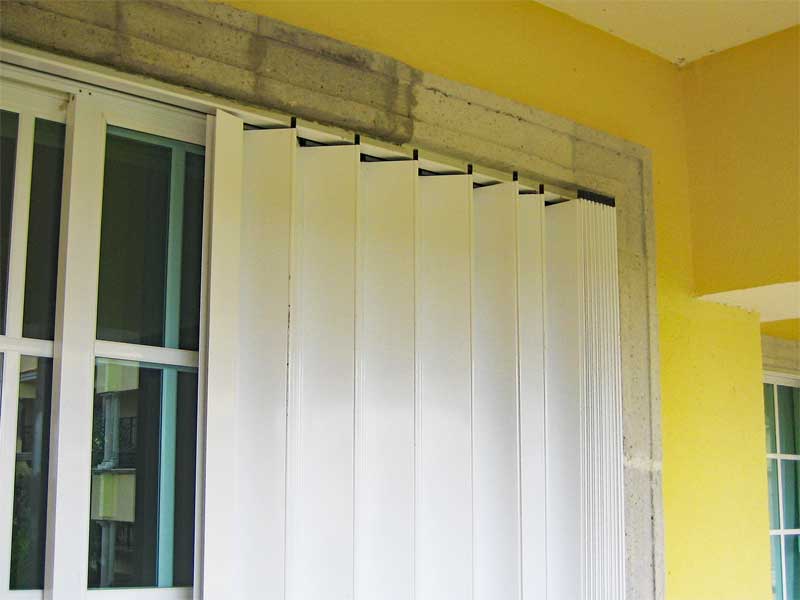
Colonial Hurricane Shutters
Exterior colonial shutters permanently hinge to either side of the window and swing closed over the opening when required. They come in multiple styles, configurations, materials and colors. Colonial shutters are easily the most attractive of all hurricane window covering options. Louvered shutters are the most common style, yet likely the least effective because space between slats allows air to pass. Solid panel shutters provide the strongest barrier between the outside elements and fragile windows. Many buildings in the Caribbean and Florida Keys have successfully used thick wood board and batten shutters for years. Exterior hinges and slide bolts hold the colonial shutters in place.
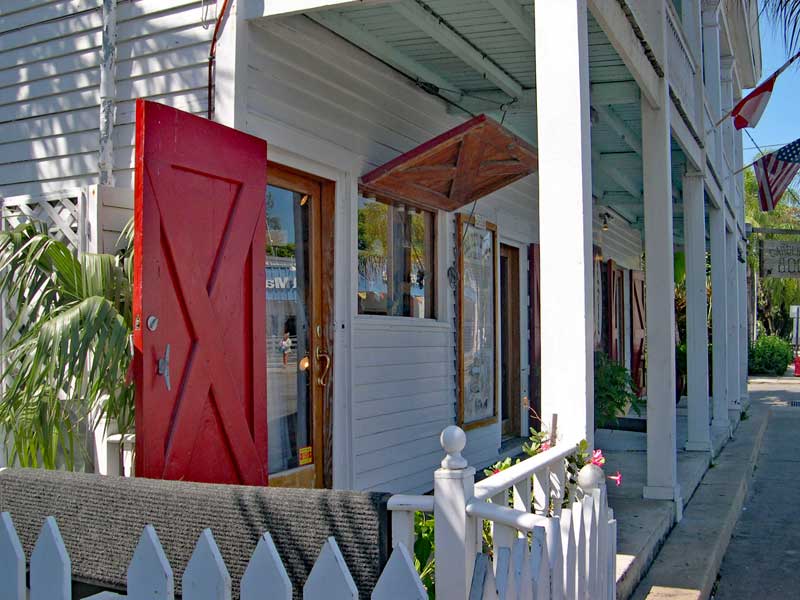
Exterior wood shutters contribute moderate resistance to powerful storms. Composite shutters are more rigid and dense than wood shutters, resulting in a stronger barrier. Metal colonial shutters are likely the best choice for waterfront or beachfront homes.
“Well, the wind is blowin’ harder now
Jimmy Buffett
Fifty knots or there abouts,
There’s white caps on the ocean.
And I’m watching for water spouts
It’s time to close the shutters
It’s time to go inside.
In a week I’ll be in gay Paris;
That’s a mighty long airplane ride.”
Trying to Reason With Hurricane Season
A1A
Bahama Hurricane Shutters
Bahama shutters are sold in the same material and color options as colonial shutters. However, they are configured to cover the entire window width, often incorporating a vertical sub-stile. Bahama shutters hinge at the top of the window and prop open at the bottom. Horizontal louvers allow for light and visibility when open. Closing Bahama hurricane shutters results in a basic layer to impede high winds, rain, and airborne particles.
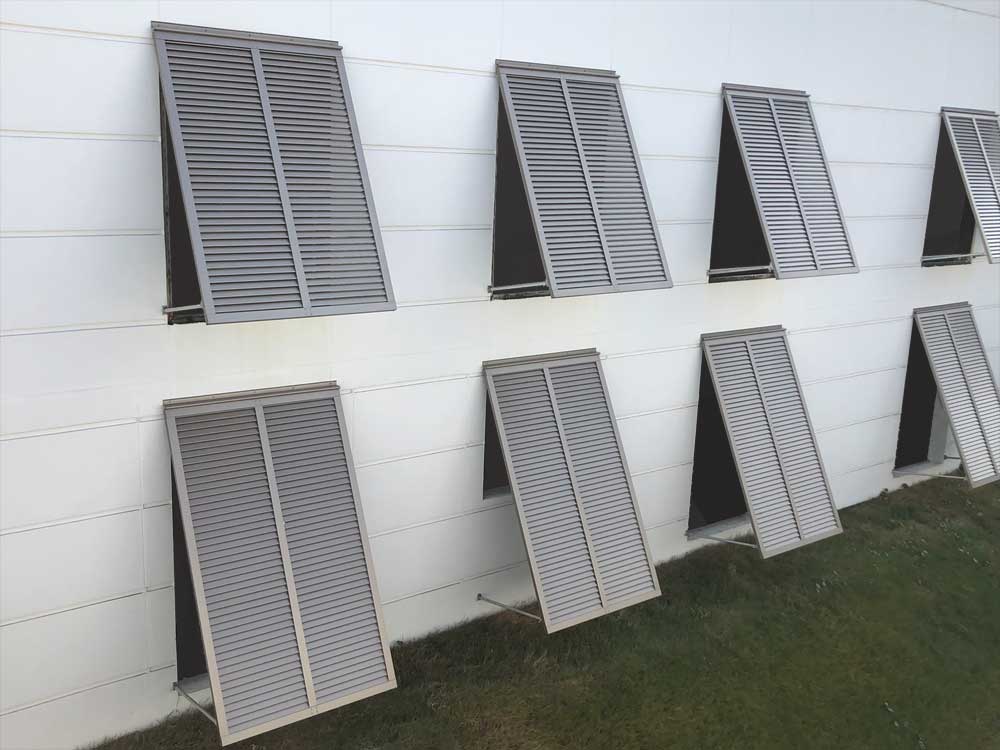
Rolling or Roll-Down Hurricane Shutters
Roll-down shutters install above the window and are enclosed in a compartment when not in use. When needed, the roll-down hurricane shutters lower in front of the opening to create a flat barricade over the window, like a garage door. Rolling hurricane shutters can operate manually or automatically when wired. Roll-down shutters are more involved to mount than other options and likely should be professionally installed. Metal or polycarbonate shutters give excellent protection and can be deployed for security as well.
Fabric Storm Panels
High-tech fabric storm panels are extremely effective in protecting exterior windows from tropical storms and hurricanes. The material can be cut for large or small openings, even garage doors. Fabric storm panels anchor at multiple predetermined locations around the window. These nylon hybrid sheets can resist winds in excess of category 5 hurricane levels. DIY fabric panels are lightweight and can be installed by the homeowner. They can be folded and store easily until they need to be called into service.
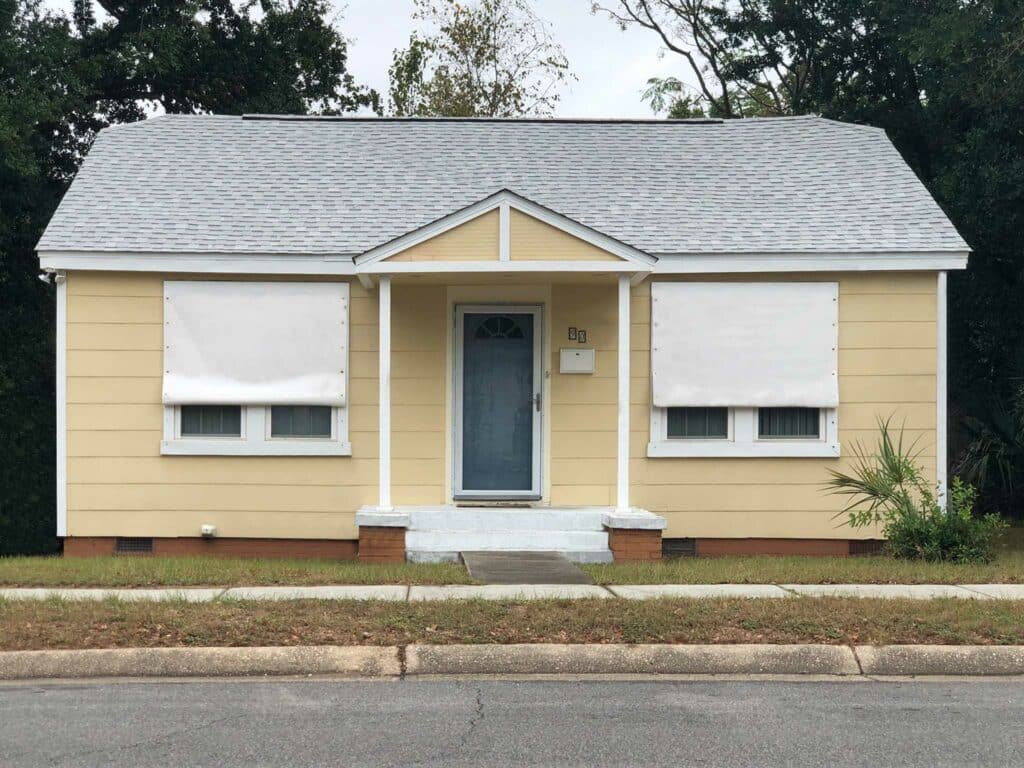
Hurricane Glass Impact Windows
High-impact windows eliminate the need for any additional fortification. This costly home improvement replaces standard windows in tropical homes. However, they can save valuable time and energy when bracing for heavy rain and wind since they are always in place.
Hurricane Shutter Building Codes
Individual municipalities establish guidelines and restrictions based on location and potential threat of hurricanes. Local codes are guided by both the International Building Code (IBC) and the International Residential Code, using the criteria set forth in ASTM E1886 & E1996 with regards to hurricane building material product approval. Manufacturers of shutters, storm panels, and windows specifically made for hurricane protection should be able to provide documentation of compliance. The term “impact resistant” is defined as shutters, windows, and doors that have been proven to resist the impact from large windborne debris (defined by the test standards as a 9-pound 2×4 lumber missile striking on end at 34 mph).
An inspection may help determine the integrity of existing storm hurricane shutters. To find out how a house or building will hold up in a hurricane, an inspector or engineer can be hired to assess the premises and pinpoint any potentially unsafe or weak areas.
Shop for Hurricane Shutters – Where to Buy
Hurricane shutters may be purchased locally or online. Handy DIY homeowners can often purchase and install colonial, Bahama, accordion, or fabric exterior hurricane shutters without difficulty. Good online retailers are proficient in providing detailed measuring and installation instructions. Rolling shutters or hurricane glass may be best installed professionally.
Factors that influence the best hurricane shutter for the application include cost, quality, building codes, and availability. Standard exterior shutters may not be able to endure the extreme weather sufficiently to protect the building. The most common styles of hurricane shutters include plywood shutter panels, roll-down hurricane shutters, accordion hurricane shutters, storm panels, colonial hurricane shutters, and Bahamas shutters. Each of these styles of exterior hurricane shutter can be constructed from various materials including aluminum and wood. Some remain affixed to the building at all times, and others are removed and stored until needed.
What do Exterior Hurricane Shutters Cost?
Like most products, the effectiveness and price of hurricane shutters and storm panels go hand-in-hand.
Plywood shutters are naturally the most affordable but require the most amount of work and lack in the quality of protection. Metal and polycarbonate panels contribute slightly better resistance with a marginally higher price tag.
Accordion shutters are next in the progression of price. Colonial and Bahama shutters sell at a similar cost. Roll-down shutters, depending on motorization, are at the top end of the range.

